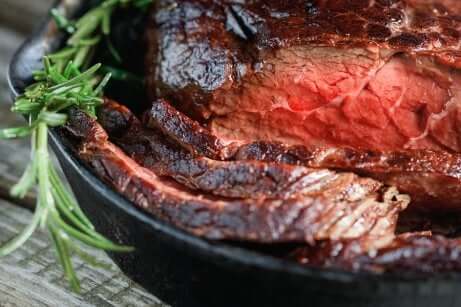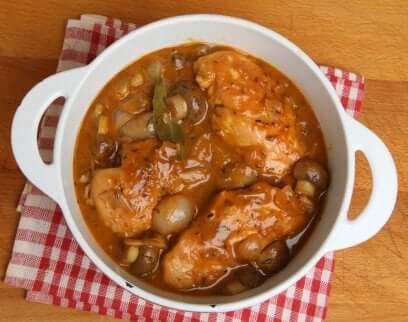4 Healthy Ways to Prepare Pork


Written and verified by the nutritionist Saúl Sánchez Arias
Pork is an excellent source of protein. Depending on the way the animal is fed, the fat it contains will be saturated or polyunsaturated. Therefore, the acorn-fed Iberian pig is of higher quality than pigs that eat feed. Depending on their diet, pork can be considered red meat (fed with feed) or white meat (with fruits). Here, we’ll show you healthy ways to prepare pork.
The most common ways to prepare it aren’t always the healthiest. Often, we eat it breaded or battered and fried. This way, in addition to increasing the acrylamide content, it has more calories.
Below, we’ll show you 4 healthy ways to prepare pork. With these methods, it won’t lose its properties, and it won’t change its caloric density.
The 2 most popular healthy ways to prepare pork
Grilled
Grilling is a fairly common way to cook pork. The key in this case is to know how to cook it perfectly. Use pieces of an appropriate thickness, about 3/4 inch, and char them on the outside, leaving the inside slightly red. It’s important not to burn or brown the meat too much to prevent the formation of acrylamide that lowers the quality.
In these situations, you can marinate the meat with garlic and spices. Then, the polyphenol content goes up, as well as its antioxidant capacity. It also gives it an interesting flavor. To improve the presentation and its nutrient content, it’s a great option to sauté or even steam some vegetables to accompany the meat.
Read also: Recipe for Cod Au Gratin with Mayonnaise
Baked
Another cooking method that requires very little oil. In this case, it’s best to cook it slowly and ensure that the temperature isn’t higher than 350ºF. Also, marinades can add more flavor, and you can garnish it with vegetables or potatoes.
This way, you can enhance the flavor of the meat and end up with a tasty meal, rich in nutrients. The protein content and vitamin B12 and folic acid, along with some minerals like zinc, are excellent.
It’s essential that the meat doesn’t brown excessively or burn. To ensure this, it’s always a good idea to puncture or cut it every so often to check that the inside is juicy. Ideally, the outside will be charred and the inside tender and soft. Also, coarse salt can enhance baked pork.

Other healthy ways to prepare pork
In rice or couscous
Pork is an excellent source of protein. However, if you need a good source of carbohydrates too, then try adding pork to your rice and couscous. The ideal thing here is to char it a little before adding it to the other ingredients. The best way to cook it is over a low heat. Additionally, you can use different types of spices.
The key to these dishes is to resist the temptation to use an alioli sauce, which would increase the caloric content. Add your favorite vegetables to improve the amount of vitamins and antioxidants. In addition, they’ll keep well in the fridge. Cover them with plastic wrap so they don’t dry out, and they’ll last for 2 or 3 days without any problem.
Discover: Artichoke: A Vegetable that May Help You Watch Your Weight
In stews
In this case, we have a traditional preparation method that combines the carbohydrates from the potato with the pork and vegetables. It’s a form of slow cooking that doesn’t spoil the product or deteriorate it. The lower the temperature and the longer the cooking time, the better.

You can add potatoes with or without skin, and the amount of meat and potatoes should be more or less similar. This dish is also good with vegetables like carrots and different types of spices. It’s great for the winter, as you eat it hot and with the broth from the meat itself.
Another great point is that it’s good frozen. This lets you store it for a long time and eat it later, since all the properties and flavor keep well. For this reason, it’s a good idea to make a lot and save the rest for later.
All cited sources were thoroughly reviewed by our team to ensure their quality, reliability, currency, and validity. The bibliography of this article was considered reliable and of academic or scientific accuracy.
- Wessels I, Maywald M, Rink L. Zinc as a Gatekeeper of Immune Function. Nutrients. 2017 Nov 25;9(12):1286. doi: 10.3390/nu9121286. PMID: 29186856; PMCID: PMC5748737.
- Chen J, Huang G. Antioxidant activities of garlic polysaccharide and its phosphorylated derivative. Int J Biol Macromol. 2019 Mar 15;125:432-435. doi: 10.1016/j.ijbiomac.2018.12.073. Epub 2018 Dec 8. PMID: 30537497.
- Aune D, Giovannucci E, Boffetta P, Fadnes LT, Keum N, Norat T, Greenwood DC, Riboli E, Vatten LJ, Tonstad S. Fruit and vegetable intake and the risk of cardiovascular disease, total cancer and all-cause mortality-a systematic review and dose-response meta-analysis of prospective studies. Int J Epidemiol. 2017 Jun 1;46(3):1029-1056. doi: 10.1093/ije/dyw319. PMID: 28338764; PMCID: PMC5837313.
This text is provided for informational purposes only and does not replace consultation with a professional. If in doubt, consult your specialist.








